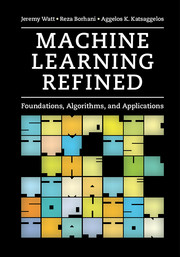Preface
Summary
In the last decade the user base of machine learning has grown dramatically. From a relatively small circle in computer science, engineering, and mathematics departments the users of machine learning now include students and researchers from every corner of the academic universe, as well as members of industry, data scientists, entrepreneurs, and machine learning enthusiasts. The book before you is the result of a complete tearing down of the standard curriculum of machine learning into its most basic components, and a curated reassembly of those pieces (painstakingly polished and organized) that we feel will most benefit this broadening audience of learners. It contains fresh and intuitive yet rigorous descriptions of the most fundamental concepts necessary to conduct research, build products, tinker, and play.
Intended audience and book pedagogy
This book was written for readers interested in understanding the core concepts of machine learning from first principles to practical implementation. To make full use of the text one only needs a basic understanding of linear algebra and calculus (i.e., vector and matrix operations as well as the ability to compute the gradient and Hessian of a multivariate function), plus some prior exposure to fundamental concepts of computer programming (i.e., conditional and looping structures). It was written for first time learners of the subject, as well as for more knowledgeable readers who yearn for a more intuitive and serviceable treatment than what is currently available today.
To this end, throughout the text, in describing the fundamentals of each concept, we defer the use of probabilistic, statistical, and neurological views of the material in favor of a fresh and consistent geometric perspective. We believe that this not only permits a more intuitive understanding of many core concepts, but helps establish revealing connections between ideas often regarded as fundamentally distinct (e.g., the logistic regression and support vector machine classifiers, kernels, and feed-forward neural networks). We also place significant emphasis on the design and implementation of algorithms, and include many coding exercises for the reader to practice at the end of each chapter. This is because we strongly believe that the bulk of learning this subject takes place when learners “get their hands dirty” and code things up for themselves.
- Type
- Chapter
- Information
- Machine Learning RefinedFoundations, Algorithms, and Applications, pp. xi - xivPublisher: Cambridge University PressPrint publication year: 2016

